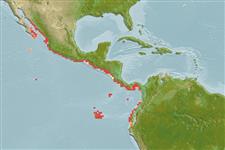Teleostei (teleosts) >
Clupeiformes (Herrings) >
Engraulidae (Anchovies) > Engraulinae
Etymology: Anchoa: Italian ancioa = anchovy (Ref. 45335).
Eponymy: Charles Tate Regan (1878–1943) was a British ichthyologist. [...] (Ref. 128868), visit book page.
More on author: Regan.
Environment: milieu / climate zone / depth range / distribution range
Ecology
Marine; pelagic-neritic; depth range 0 - 50 m (Ref. 189). Tropical; 28°N - 5°S, 111°W - 77°W (Ref. 189)
Eastern Pacific: southern half of Gulf of California to Ecuador, excluding the Galapagos Islands.
Size / Weight / Age
Maturity: Lm ? range ? - ? cm
Max length : 12.5 cm TL male/unsexed; (Ref. 96339); common length : 8.0 cm TL male/unsexed; (Ref. 55763)
Dorsal spines (total): 0; Anal spines: 0; Anal soft rays: 14 - 17. Body fairly elongate. Snout long, about equal to eye diameter; maxilla moderate, tip rather bluntly pointed, reaching onto inter-operculum, but not to edge of gill cover; gill cover canals of panamensis-type. Anal fin very short, its origin below or behind last dorsal fin ray base. A silver stripe along flank, about 3/4 eye diameter.
A schooling species found in coastal waters. Caught over sand or gravel in the Gulf of Nicoya but not in inner parts of the Gulf. May spawn over a protracted period in Gulf of Nicoya. The eggs are oval. TL = 1.25 SL.
Life cycle and mating behavior
Maturity | Reproduction | Spawning | Eggs | Fecundity | Larvae
May spawn over a protracted period in Gulf of Nicoya (Ref. 189). Spawn in school (Ref. 205).
Whitehead, P.J.P., G.J. Nelson and T. Wongratana, 1988. FAO Species Catalogue. Vol. 7. Clupeoid fishes of the world (Suborder Clupeoidei). An annotated and illustrated catalogue of the herrings, sardines, pilchards, sprats, shads, anchovies and wolf-herrings. FAO Fish. Synop. 125(7/2):305-579. Rome: FAO. (Ref. 189)
IUCN Red List Status (Ref. 130435: Version 2024-1)
Threat to humans
Harmless
Human uses
Fisheries: subsistence fisheries
Tools
Special reports
Download XML
Internet sources
Estimates based on models
Preferred temperature (Ref.
123201): 22.9 - 28.5, mean 26.6 °C (based on 46 cells).
Phylogenetic diversity index (Ref.
82804): PD
50 = 0.5000 [Uniqueness, from 0.5 = low to 2.0 = high].
Bayesian length-weight: a=0.00513 (0.00234 - 0.01125), b=3.14 (2.97 - 3.31), in cm total length, based on LWR estimates for this Genus-body shape (Ref.
93245).
Trophic level (Ref.
69278): 3.4 ±0.4 se; based on size and trophs of closest relatives
Resilience (Ref.
120179): High, minimum population doubling time less than 15 months (Preliminary K or Fecundity.).
Fishing Vulnerability (Ref.
59153): Low vulnerability (10 of 100).
Nutrients (Ref.
124155): Calcium = 338 [181, 810] mg/100g; Iron = 2.18 [1.13, 4.02] mg/100g; Protein = 16.9 [14.6, 19.7] %; Omega3 = 0.303 [0.148, 0.631] g/100g; Selenium = 43.8 [18.8, 102.9] μg/100g; VitaminA = 30.5 [7.8, 99.9] μg/100g; Zinc = 1.85 [1.24, 2.75] mg/100g (wet weight);
